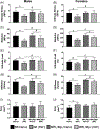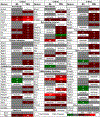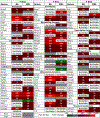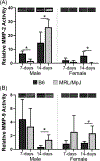Superior mechanical recovery in male and female MRL/MpJ tendons is associated with a unique genetic profile
- PMID: 32352601
- PMCID: PMC7606617
- DOI: 10.1002/jor.24705
Superior mechanical recovery in male and female MRL/MpJ tendons is associated with a unique genetic profile
Abstract
Tendon ruptures heal by forming a mechanically inferior scar. We have shown that male Murphy Roths large (MRL/MpJ) mice exhibit improved tendon healing, suggesting that they can inform biological mechanisms that lead to effective tendon healing. As sex impacts healing, we assessed the effect of sex on tendon healing in MRL/MpJ and normal healer C57BL/6 (B6) mice and compared the associated biological environment with identify genes that may be integral to the improved healing outcome. We hypothesized that (a) male MRL/MpJ mice will heal with improved mechanical properties compared to females; and (b) that regenerative tendon healing will be associated with decreased fibrotic pathways, decreased inflammation, and increased activity of matrix metalloproteinases (MMPs). A midsubstance punch was introduced, and tendons were harvested after (a) 1 or 7 days for profiling of 84 genes; (b) 7 or 14 days for the assessment of MMP-2 and MMP-9 activity; and (c) 6 weeks for mechanical assessment. MRL/MpJ tendons healed with the better restoration of mechanical properties than B6 tendons. Sex did not affect the mechanical properties of healing B6 or MRL/MpJ tendons. Comparison of the gene expression profiles in the context of the mechanical outcome revealed several differences between MRL/MpJ and B6 tendon healing, including, lower inflammation, an earlier higher expression of TGF-β-related genes that diminish by 7 days, and genes associated with enhanced cell migration in MRL/MpJ in comparison to B6 tendons. We expect that the timecourse and expression levels of these genes in scarless MRL/MpJ tendon healing represent the balanced environment that leads to improved tendon healing.
Keywords: PCR array; regeneration; scarless healing; tendon injury.
© 2020 Orthopaedic Research Society. Published by Wiley Periodicals LLC.
Figures





References
-
- Maffulli N, Wong J. Rupture of the Achilles and patellar tendons. Clin Sports Med. 2003;22(4):761–776. - PubMed
-
- Thomopoulos S, Williams GR, Soslowsky LJ. Tendon to bone healing: differences in biomechanical, structural, and compositional properties due to a range of activity levels. J Biomech Eng. 2003;21(3):413–419. - PubMed
Publication types
MeSH terms
Substances
Grants and funding
LinkOut - more resources
Full Text Sources
Research Materials
Miscellaneous

